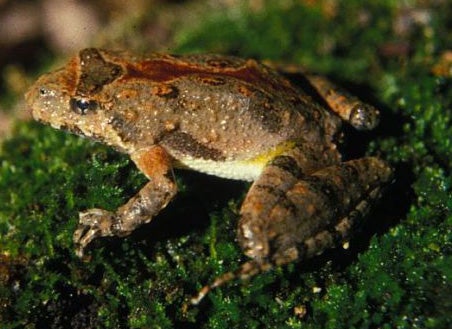SCIENTIFIC NAME:
Acris crepitans crepitans
STATUS:
Common above Fall Line Hills and locally common in Coastal Plain. Occurs essentially statewide. Lowest Conservation Concern.
DESCRIPTION:
A small frog attaining a maximum length of 1.5 inches. Northern cricket frogs are highly camouflaged. Their dorsal (back) coloration includes grays, greens or browns and varies widely from very colorful to almost drab. Their skin is bumpy with variable spots or blotches. The underside is light colored or white, their snout is rounded with narrow, vertical light lines and they have longitudinal dark stripes on the back of the thigh. The tips of the digits are slightly rounded and the webbing of the hind foot is quite extensive, reaching from the tip of the first toe to the next-to-last joint of the longest (4th) toe.
Cricket frogs are identified by a dark triangle located between the eyes and prominent light, almost white, warts which are usually present on each side of the vent. The northern cricket frog is similar in appearance to the southern cricket frog; however, the former has shorter hind legs, more webbing on the hind feet and a more rounded snout. In addition, the line on the back of the thigh is less defined than those on the back of the southern cricket frog.
DISTRIBUTION:
Contrary to what their name implies, northern cricket frogs are found from southern New York to Florida and west to Texas. In Alabama, they are found statewide, and are widespread and abundant in most areas.
HABITAT:
The northern cricket frog is diurnal (active during the day) and is found in a wide variety of aquatic habitats including streams, ponds, lakes and floodplain pools. They prefer sunny ponds of shallow water with sparse vegetation growth either in the water or along the shore, or slow-moving streams with sunny banks. Northern cricket frogs normally avoid places that dry up periodically or places with too much dense low vegetation.
FEEDING HABITS:
Feeds on a variety of small insects including mosquitoes.
LIFE HISTORY AND ECOLOGY:
Breeds from March through July or into August. Males call to attract females with a shrill clicking “Gik-gik….gik”, that is said to resemble the sound made by striking two pebbles together. The call starts slowly at first, and then becomes more rapid. The northern cricket frog gets its name because of the similarity of its call resembling that of an insect. The scientific name Acris comes from the Greek word meaning locust and crepitans is Latin for clattering; or clattering locust or insect.
The female lays up to 200 eggs, either singly, or in small clusters, along the pond bottom, or attached to objects in the water. After a few days the tadpoles hatch, are about an inch long, and usually have black tips on their tales. They are the only tadpoles that have black tipped tails.
Though they are members of the treefrog family, they are not climbers. They lack the large sticky toe pads of most treefrogs, so they are forced to stay close to the ground. Exceptional camouflage allows northern cricket frogs to be less wary than many other species of treefrogs. Once startled, they are active and aggressive leapers, able to leap more than three feet in one jump.
References:
Knopf, Alfred A. 1979. The Audubon Society Field Guide to North American Reptiles and Amphibians. Chanticleer Press, Inc. New York. 743 pp.
Mount, Robert H. 1975. The Reptiles and Amphibians of Alabama. Auburn Printing Company, Alabama. 347 pp.
Minnesota Department of Natural Resources. 2007. The Minnesota Department of Natural Resources Web Site (online). https://www.dnr.state.mn.us/rsg/profile.html?action=elementDetail&selectedElement=AAABC01040
https://hiltonpond.org/ThisWeek050322.html
Author: Marisa Lee, Wildlife Biologist, Alabama Division of Wildlife and Freshwater Fisheries






